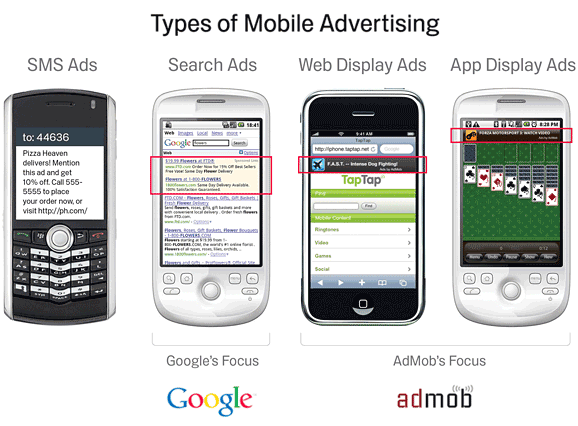![]() Google said it will buy mobile ad network AdMob for $750 million in stock today, letting the search giant further muscle its way into mobile advertising and extend the dominance it has built on the web in search-based advertising.
Google said it will buy mobile ad network AdMob for $750 million in stock today, letting the search giant further muscle its way into mobile advertising and extend the dominance it has built on the web in search-based advertising.
San Mateo-based AdMob (see our profile) is the biggest player in mobile web and app ads, a market that has become particularly sexy now that smartphones such as the iPhone and other mobile-browser friendly devices are driving an explosion in mobile ads.
Admob served at least 10.2 billion ad impressions per month, up from 5.1 billion a year ago, and only 1.6 million two years ago. Accel Partners’ Richard Wong, who led Accel’s investment into Admob three years ago, said there had been multiple suitors of Admob, making the negotiations exhausting.
 AdMob was founded three years ago by Omar Hamoui (pictured left).
AdMob was founded three years ago by Omar Hamoui (pictured left).
Google says AdMob patches up holes in its mobile advertising offerings: Google specializes in search ads, and only recently started building out its display network aggressively, with things like mobile adsense, which allows advertisers to place ads by relevant content just as they do for laptops and desktops. AdMob brings mobile display ads to the table in a very big way. It has, in contrast to Google, built a network that began by serving lower-end phones but then more recently started targeting the iPhone.
Google hadn’t focused much on the iPhone, in part because it had built a competing mobile phone system called the Android operating system. It’s now the basis of dozens of smartphones and is poised to come into its own over the next year with models like the Motorola Droid unveiled last week.
With AdMob’s exclusive focus on mobile, especially the iPhone and its exploding application ecosystem, the biggest treasure it offers Google is its know-how in terms of dealing with app publishers and advertisers.

Admob employs 140 people and its business is “exploding 200 to 300 percent a year,” Wong said. It is serving ads in 160 countries, and on 15,000 mobile web sites and iPhone and Android applications.
Recently, Admob acquired AdWhirl, another company that had tried to build a mobile ad network that aggregated other networks. Google had remained remarkably quiet in this sector, and rumors began to build that it would either launch a major effort in this area, or acquire a player like Admob.
AdMob was backed by Accel Partners, Sequoia Capital, Draper Fisher Jurvetson’s Growth Fund and Northzone, with more than $47 million in funding, so $750 million represents a nice exit for AdMob’s investors at more than 10 times the initial investment. It’s a particularly lucrative day for Accel, which also saw another company it had backed, Playfish, sold for as much as $400 million to Electronic Arts.
A year ago, VentureBeat wrote a story about how AdMob was poised to “mint money,” and outlined the promise of the budding companies business, and some critics weighed in, and suggested AdMob’s business wasn’t as solid as we’d suggested. Turns out, even despite the recession, Admob came out ahead.

Founder Omar Hamoui struggled for a breakthrough in mobile advertising for several years, which was difficult until the iPhone came along. Even then, the result is remarkable considering the company was founded in 2006. He wrote today:
“I’ve been working in mobile for over 7 years now. Before AdMob, I founded two separate mobile startups that never got significant traction. It was so frustrating to build what I knew was an incredible service only to find myself unable to distribute or monetize the product without a carrier or handset deal.
….
Then came the iPhone. Suddenly, Apple solved so many problems that had plagued mobile for so long. They showed all of us the way forward and their efforts have led to a landslide of rapid improvements in our space. We were so excited by the promise the iPhone represented that we shifted a significant portion of our attention to that device in its very early days. We launched the first iPhone ad units focused on the web and quickly added the capability to run ads in applications. Now with the addition of excellent devices from Palm, Nokia, RIM, and plethora of Android powered smartphones, we have all the preconditions necessary for what will be a tidal wave of mobile browsing and app usage. But let there be no mistake. Our business, and the mobile industry in general, owes Apple a debt of gratitude.
We now operate in an environment that is much more advanced than the one we entered into a few years ago. There are literally hundreds of competitors, small and large, with different areas of focus and expertise. Lately, it seems that almost every week we hear about a new idea or company in the mobile advertising space. This has led to rapid innovation, and we’re excited about the positive attention this deal will bring to mobile advertising. We have no doubt this will bring even more players into the space and accelerate all the innovation that is already taking place.”

